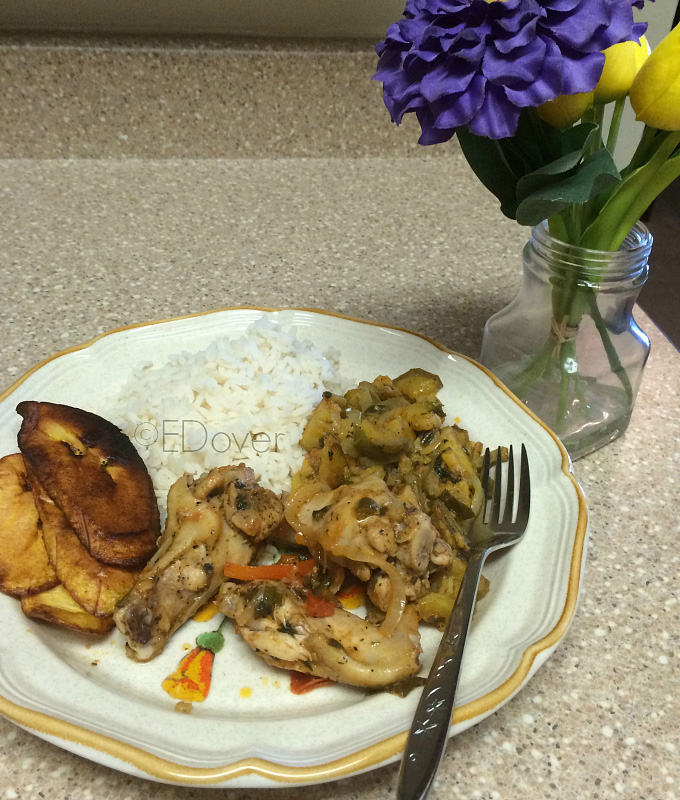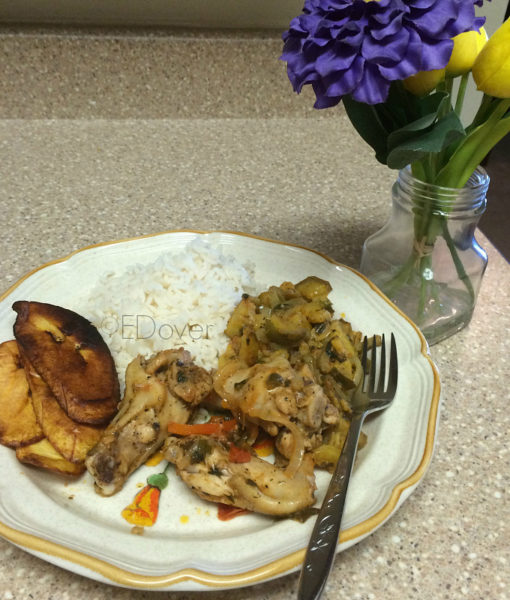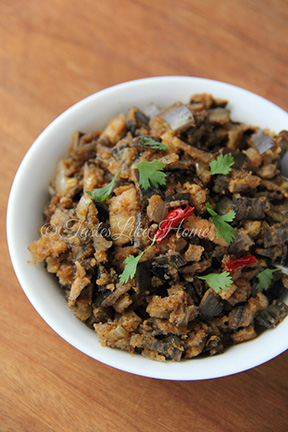Hi Everyone,
The next time you peel green or turning plantains to cook, do not throw away the skins. The skins are not only edible but they are an excellent source of fibre.
 I’ve made and eaten skin-on green banana and plantain chips before so I know the skins are edible but I had not considered cooking and eating the skins as a vegetable. However, several years ago I encountered a blog post by a doctor in India in which she showcased a dish of finely chopped green plantains skins sautéed with onions and whole spices. The doctor simply described the dish as being crunchy and a good source of fiber. Of course I was immediately intrigued, but I never got around to cooking the skins until recently. I extended an invitation to a group of friends on Facebook to join in the experiment. While several persons expressed interest, time and skepticism kept most of them at bay, but two former Guyana Broadcasting Corporation (GBC) colleagues – Eartha Dover and Lynette Baird-Fiedtkou – committed, and shared their experiences.
I’ve made and eaten skin-on green banana and plantain chips before so I know the skins are edible but I had not considered cooking and eating the skins as a vegetable. However, several years ago I encountered a blog post by a doctor in India in which she showcased a dish of finely chopped green plantains skins sautéed with onions and whole spices. The doctor simply described the dish as being crunchy and a good source of fiber. Of course I was immediately intrigued, but I never got around to cooking the skins until recently. I extended an invitation to a group of friends on Facebook to join in the experiment. While several persons expressed interest, time and skepticism kept most of them at bay, but two former Guyana Broadcasting Corporation (GBC) colleagues – Eartha Dover and Lynette Baird-Fiedtkou – committed, and shared their experiences.
There were no pre-set guidelines or parameters for cooking the plantain skins except that the recipe I had seen used the skin of green plantains and that it was ‘fried’ in a similar way in which we fry vegetables in Guyana. Also, based on my experience cooking the skins, I suggested to Eartha and Lynette that they par-cook the skins before cooking them in their final dishes.
In their own words, here’s what Eartha and Lynette did.
Eartha Dover
Dish
Stewed Plantain Skins with Chicken (the plantain skins were cooked separately then mixed in with the chicken when ready to serve).
Process
I first prepared a bowl with warm water and salt because I did not want the green skins getting black. The green plantains were washed and the top and bottom tips cut off. After peeling the plantains the skins were cut into small pieces and dropped directly into the warm salted water.
A pot of water was brought to a boil and the skins added. Because the skins were soaking in salted water, they absorbed some of the salt so I did not need to add salt to the boiling water. I did not time how long the skins took to cook, I judged the doneness when I tasted a piece of the plantain skin and the texture (softness) was to my preference. I drained the skins.
I cut up onions, peppers, tomatoes, eschallots etc, fried everything in a little oil and then added the plantain skins. With everything mixed together, the heat was turned low so that the skins could absorb the flavours of the seasonings.
Serving & Taste
The plantains skins and chicken were served with plain white rice and fried turning plantains. I shared the meal with my son and daughter-in-law (I did not tell them what the vegetable was until they were finished eating). They both loved the dish. Some friends had come over to visit and they sampled the dish too. I got 2 thumbs up from everyone.
I like the dish very much; the texture was excellent, it had good flavour, especially with the seasonings I used. Actually, if I did not tell you what it is you are eating you would think that it is just another vegetable.
Going forward
I would definitely cook plantain skins again. I think that the skins can be used to make other dishes and I am thinking of trying out a pie similar to macaroni and cheese but instead of a large dish, I would make them in little muffin pans.
Lynette Baird-Fiedtkou
Dish
Fried Plantain Skins (I used turning plantains)
Process
I peeled the plantains and cut the skins into small pieces just as I would cut karaila (corrila). I boiled the skins for about 2 minutes to get rid of any kind of stain-effect in my mouth.
I cut up herbs and local seasonings like eschallots, celery, dried fine leaf thyme, ginger and some seasoning from Grenada. I also added sweet peppers and wiri wiri peppers to the fry up. The herbs and seasonings were fried up and then I added the drained plantain skins. The dish took several minutes to cook so that the flavour from the seasoning could mix with the skins.
Serving & Taste
I served the fried plantains skins with dhal, rice and bounjal chicken. I did not tell my household beforehand what it was. I know that if I did, that they would refuse to eat it. I know also that they would have eaten it because they like curry and dhal.
It tasted delicious. At first I thought that I would not be able to eat it knowing that it was plantain skins. Back home in Mabaruma, we feed our pigs plantain skins. I served it first to my household for lunch and everyone ate all of it and then I ate it.
I told a friend at work about it and she said, “Plantain skin?! Not me, you try deh!” The next day when I shared my lunch with her, she ate all of it without complaining. When she was done eating I told her that she had eaten the plantain skins. She ran around the office in protest but said that she did not regret eating it. However, she confessed that she would not have eaten it if she had known before that it was plantain skins.
Going forward
I would definitely cook the skins again. It surprised me; I thought that it would not have tasted good.
I believe that we can cook it just like we cook other vegetables with meat like beef or chicken or with fried fish on the side. To me it is more suited as a vegetarian dish and it is really good with dhal and rice. Actually, I think it can be used as another curry in 7-curry.
My takeaways from Eartha and Lynette’s experience with the plantain skins are:
Soaking the skins in warm salted water is genius; is stops the oxidation and simultaneously seasons the skins.
Serving the skins with foods their family like, and favourites, is a sure way to incorporate new ingredients into one’s diet.
Not revealing upfront what people are eating is still one of the best ways to get people to try new things.
For my part, I cooked the skins in the style of a boil and fry. I was planning to make boil and fry green plantains so I thought that I would do the same thing with the skins. At first I was put off by the oxidized skin – the beautiful green skins turned black after cooking (this is why Eartha’s soaking in warm salted water is such a great idea).
Long before getting Lynette’s feedback, I had decided that I was going to eat the skins with dhal and rice. I find dhal and rice to be good combo with which you can try many new things.
When I tasted the cooked skins, the texture was soft without being mushy and I found that the skins did not have flavour so I figured from my little cooking knowledge that it would need some aggressive seasoning and that the skins would ultimately take on the flavours of whatever it is cooked with. That is a fact that was clearly borne out by Eartha and Lynette’s use of multiple herbs and aromatics in cooking their plantain skins. Therefore, instead of the usual onions, garlic, tomatoes and herbs for a fry up I opted to fry the cooked, chopped skins with a spicy coconut paste made of fresh coconut, sesame seeds, peanuts, pepper and garam masala (see the full paste recipe tomorrow, In Good Taste).
The chopped skins and coconut paste were added to heated oil, mixed together, and cooked over low heat for several minutes until the pan was dry and the paste adhered to the skins. It tasted really good with the dhal and rice, but like the others, I can see it being cooked with meat or chicken – dry or in a stew. You would not know that it is plantain skins if someone does not tell you it is.
Some other ways in which I think the cooked skins can be used – minced very finely in a food processor and used as a large portion of the bread in stuffing. Minced very finely and mixed together with a little breadcrumbs and egg to make into fritters or patties or mixed with ground rehydrated split peas or other similar beans to make fritters. I am looking forward to Eartha’s experiment with cooking the skins in a style of macaroni and cheese.
It is always exciting learning of new ways to cook and enjoy food that reduces waste. Don’t you think?
Cynthia








